What Do You Call the Gear Shifter in a Car UPDATED
What Do You Call the Gear Shifter in a Car

The common five-speed shift pattern

A gear stick (rarely spelled gearstick),[1] [two] gear lever (both UK English), gearshift or shifter (both U.S. English language), more formally known equally a manual lever, is a metal lever attached to the manual of an automobile. The term gear stick generally refers to the shift lever of a manual manual, while in an automatic transmission, a similar lever is known every bit a gear selector. A gear stick volition normally be used to modify gear whilst depressing the clutch pedal with the left pes to undo the engine from the drivetrain and wheels. Automatic transmission vehicles, including hydraulic (torque converter) automated transmissions, automated manual and older semi-automated transmissions (specifically clutchless manuals), like VW Autostick, and those with continuously variable transmissions, do non require a concrete clutch pedal.
Alternative positions [edit]


Steering wheel with column-mounted gear lever in a West 120-series Mercedes-Benz 180
Gear sticks are almost commonly constitute between the front seats of the vehicle, either on the centre panel (sometimes even quite far up on the dashboard), the transmission tunnel (erroneously called a console shifter when the floor shifter mechanism is bolted to the manual tunnel with the heart console to cover upwardly the shifter assembly when used with a rear or front-bicycle bulldoze vehicle), or directly on the flooring. Some vehicles have a cavalcade shift where the lever is mounted on the steering column — in vehicles with a manual four-speed gearbox such as 1950s Mercedes-Benz cars and all ii-stroke Trabants, this is actually a manual gear lever continued to the gearbox with a linkage. In automatic transmission cars, the lever functions more than like a gear selector, and, in modern cars, does not necessarily need to have a shifting linkage due to its shift-by-wire principle. It has the added benefit of allowing for a total width bench-blazon front seat (though some models with saucepan seating as an option include it). It has since fallen out of favor, although it tin still be found widely on North American-marketplace pick-upwardly trucks, vans, emergency vehicles (both constabulary enforcement and European monetary system - the column shifter is retained where a floor shifter is unfeasible due to mounting the mobile information final and ii-style radio), and "full-size" US sedans such as the Ford Crown Victoria. A dashboard mounted shift was common on certain French models such as the Citroën 2CV and Renault four. Both the Bentley Mark 6 and the Riley Pathfinder had their gear lever to the right of the right-hand drive driver'south seat, alongside the driver's door, where it was not unknown for British cars to also have their handbrake. (Left-paw bulldoze models received a cavalcade shift.)
In some modern sports cars, the gear lever has been replaced entirely by "paddles", which are a pair of levers, usually operating electrical switches (rather than a mechanical connection to the gearbox), mounted on either side of the steering column, where 1 increments the gears upwardly, and the other down. Formula 1 cars used to hide the gear stick behind the steering bicycle within the nose bodywork before the modernistic practice of mounting the "paddles" on the (removable) steering wheel itself.
Gear knob and switches [edit]

A knob showing the driver the position of each gear
A knob, variously called gear knob, shift knob, gear shift knob or stick shift knob, forms the handle for the gear stick. Typically the gear knob includes a diagram of the shift pattern of the gear selection system, i.due east. the positions to which the gear stick should be moved when selecting a gear. In some older manual manual vehicles, the knob may incorporate a switch to engage an overdrive; in some automated transmission vehicles it may contain a switch to engage a special mode such equally a sports mode or to disengage overdrive. Both of the above-mentioned switches may as well exist found on the panel or on steering column stalks instead. Manual shifters on the steering column, if having simply three frontwards speeds, are typically chosen a "three on the tree". The lowest of these gears, if set at a much lower ratio than a typical 1st-gear ratio, is ofttimes chosen a "granny gear".
Starting the auto in gear with the clutch engaged causes it to lurch forrad or backward since the starter motor by itself produces sufficient torque to move the whole vehicle; this can exist highly dangerous, especially if the parking restriction is not firmly applied and can be injurious to the starter and drivetrain. Therefore, novice drivers are taught to rock the knob of a manual gearbox from side to side earlier starting the engine to confirm that the gearbox is in neutral. For the same reason, modern cars require the clutch pedal to be depressed before the starter will appoint (though some mod vehicles have a push button that disables the clutch first requirement if held down when starting, for rare situations when starting the car in gear is necessary). The latter practice is as well useful in extremely cold atmospheric condition or with a weak battery, every bit it avoids the starter motor also having to plough over a gearbox full of cold and highly viscous oil.
Many automatic transmission vehicles accept actress controls on the gear stick, or very close by, which alter the choices fabricated by the manual system depending on engine and road speed, e.thou. "sports" or "economic system" modes which volition broadly speaking permit, respectively, for higher and lower revolutions per minute, before shifting upward.
Some specialist vehicles have controls for other functions on the gear stick. The Land Rover Freelander introduced a push for that company's Loma Descent Control organisation feature, which uses the brakes to simulate the function of a low-ratio gearbox in steep descents.
Secondary gear levers [edit]
In some traditional four-wheel drive vehicles there can be a 2nd gear lever which engages a low-ratio gearbox, used on tough terrain. Further, a similar-looking lever called a transfer case switches between two- and four-wheel drive, or appoint differential locks; these are not "gear levers," nonetheless.
Shift blueprint [edit]

half dozen-speed gear shifter from 2015 Volkswagen Passat Estate
The shift design refers to the layout of the gears. In a typical manual transmission automobile, start gear is located to the left, and frontwards. In many trucks and some sports cars it is instead in a "dog leg" position, to the left and rearwards. There is usually a bound-loading to return the stick to the cardinal position. Opposite gear is commonly positioned in the best choice of location to avert adventitious engagement.
Manual transmission [edit]



A typical manual transmission vehicle, with (for example) 5 forward gears, will thus have seven possible positions: the five forwards gears, reverse gear, and a central "neutral" position. Some vehicles have a special button to prevent adventitious engagement of reverse. Others require that the lever be lifted, pressed downwardly, or moved with extra force to appoint opposite. In transmissions with reverse directly below fifth, at that place may be a mechanical lock-out preventing choice of reverse other than from neutral, thus preventing a driver used to a 6-speed transmission from engaging reverse while trying to select 6th. Some transmissions also accept an electronically controlled error-prevention safeguard that blocks the get-go and sometimes the second gear from beingness selected if the vehicle is moving fast enough to exceed the engine's maximum RPM.
| Layout | Description |
|---|---|
 | This shift pattern is the most common 5-speed shift design. This layout is reasonably intuitive because it starts at the upper left and works left to correct, superlative to bottom, with reverse at the stop of the sequence and toward the rear of the machine. |
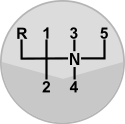 | This shift pattern is some other five-speed shift pattern which tin exist found in Saabs, BMWs, some Audis, Eagles, Volvos, Volkswagens, Škodas, Opels, Hyundais, about Renaults, some diesel Fords, most Holden/Vauxhalls and more. The selection of the reverse gear is to prevent the reverse gear from being selected accidentally while the vehicle is in movement, causing catastrophic damage to the manual. |
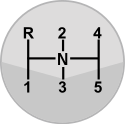 | This shift pattern, sometimes called a Domestic dog leg shift pattern is used on many race cars and on older route vehicles with iii-speed transmissions. The name derives from the up-and-over path between get-go and second gears. Its use is common in race cars and sports cars, but is diminishing as half dozen-speed and sequential gearboxes are becoming more common. Having outset gear across the dogleg is beneficial equally first gear is traditionally only used for getting the car moving and hence information technology allows second and tertiary gears to be aligned fore and aft of each other, which facilitates shifting between the ii. As nearly racing gearboxes are non-synchromesh in that location is no appreciable delay when upshifting from start through the dogleg into 2d. This gear pattern tin also be found on some heavy vehicles – such equally lorries and tractors – in which first gear is an extra-low ratio for use in extreme continuing-start weather, and would see fiddling employ in normal driving. |
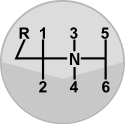 | This shift pattern is a typical pattern for a six-speed transmission. Six speeds is the maximum commonly seen in unmarried range transmissions, yet many semi-trucks and other large commercial vehicles have manual transmissions with 8, 16 or fifty-fifty twenty speeds, which is made possible due to multi-range gearboxes. In such a case, Reverse is placed outside of the "H," with a canted shift path, to preclude the shift lever from intruding besides far into the driver's space (in left-hand drive cars) when reverse is selected. Higher number of speeds in automobiles are rare occurrences, although examples do exist, such as the Porsche 911, which is equipped with a seven-speed manual transmission. |
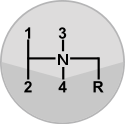 | Shift design for a 4-speed car. Also found in column shift (Citroën DS/ID and Peugeot 404 from September 1967 onwards). |
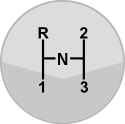 | Shift blueprint for a 3-speed car. |
 | Shift pattern for a 4-speed cavalcade shifter. Constitute like this in Peugeot 403 and 404 until September 1967. |
Automatic transmission [edit]
Automatic transmissions traditionally have had a directly blueprint, adopting the classic P-R-N-D gate, with "P" existence to the front end, topmost position (or "P" all the way to the left on a column-mounted shifter); the corresponding shift positions being:
- P = Park - manual is mechanically locked in position for parking, via a parking pawl.
- R = Reverse - opposite movement
- N = Neutral - no drive applied to the wheels with the engine running
- D = Drive - forward motility with fully-automatic performance in all gears.
All automatics use some sort of manual override of the transmission, with numbered positions in descending club marked below (or to the right) of "drive", which will preclude the manual shifting to a gear higher than the selected, only maintaining automatic operation between all lesser numbered gears. Such gates will appear as P-R-N-D-3-ii-1 for instance. On some vehicles (mainly Japanese makes such every bit Honda, Toyota and Lexus) these numbered positions are replaced past a single "L" (for "low") position, which will hold the manual in whatever lower ratio is required for climbing steep grades or for heavy dispatch: P-R-N-D-L.
More modern automated transmissions have employed a "J-gate" (pioneered by Jaguar) where some gears are on the left-hand "arm", some on the correct, and in that location is a sideways movement at the rear of the design. The second-generation Range Rover from 1995 used an "H-gate", with two parallel PRND gates on the opposing legs of the "H" for both high range and depression range ratios, for normal and off-road driving, respectively.
Some modern gearboxes, namely manumatics, such equally Alfa Romeo Sportronic, and Porsche Tiptronic, has a traditional automatic shift design to the correct, with a special position to the left in which movement of the stick frontwards and backward increments the gears up and down respectively. This tin can be useful in snow or dirt conditions, where information technology may exist necessary to start from 2d gear.
Electronic gear shifts [edit]

Interior of a 2010 Jaguar XF; with a rotary knob manner gear selector on the central console
With the advent of bulldoze by wire (or more properly, shift past wire) computer-controlled transmissions (particularly in the instance of automatics), the gear stick no longer needs to be mechanically connected to the manual unit itself, and tin, therefore, be made much smaller since there is no need to packet either remote mechanisms or complex interlocking arrangements. This has allowed designers to replace the gear stick completely with either button, rotary knobs (current Jaguar, State Rover and Ford models are good examples of this), or a miniaturized gear stick on the center console. This tin be seen in some Audis, BMWs and the Lincoln Continental. Japanese finger shift is another example. It is a revival of an arroyo used in the 1950s by the Chrysler push button-push PowerFlite and the Packard Touchbutton Ultramatic.
Special knobs [edit]
A shift knob likewise known as a gear knob, gear shift knob and stick shift knob is the physical interface betwixt the gear stick and the commuter'south hand. Fabricated of many materials from uncomplicated plastics through to platinum, it comes in many shapes sizes and weights. OEM shift knobs are generally spherical in shape, often resembling a chess pawn when fastened to the gear stick.
The shift knob's principal function is the ergonomical interface between driver and the manu. The gear stick, as the name implies, is often just a machined or cast aluminium or steel rod with or without threading the shift knob is fitted on its finish.[3]
In recent years, manufacturers have increased the variety of shifts knobs available to the consumer from inexpensive plastics to diamond-studded white golden.[4]
-

'Big Daddy' Ed Roth 'bloodshot eyeball' shift knob, a 1960s craze
-

Stylized shift knobs can be found on many types of vehicles. This aluminum, paw made, skull shift knob is mounted on a vintage Harley Davidson Knucklehead's "jockey shifter".
Weighted shift knobs [edit]
A weighted shift knob is a performance-driven aftermarket modification which entirely replaces the OEM shift knob and sits atop the aftermarket brusk shifter or OEM manual shift stick. Initially designed to be used in tandem with a curt shifter, it is increasingly existence purchased for stock stick shifts. The weight mostly varies between 400 and 600 grams or more than, depending on the fabric used. The principle of the weighted shift knob is to make the stick shifter top-heavy, thus increasing the throw momentum in gild to decrease the time between shifts. Weighted gear knobs are offered for auction past a variety of North American-based manufacturers in many shapes and finishes, though they are significantly more expensive than the ordinarily bachelor aftermarket shift knob.
References [edit]
- ^ "gear lever - Definition of gear lever in US English language past Oxford Dictionaries". Oxford Dictionaries - English.
- ^ "gear lever Meaning in the Cambridge English Dictionary". dictionary.cambridge.org.
- ^ U.Southward. Patent 4,896,556 Shift lever knob – Nissan Motor Co., Ltd. (1990-01-30). Retrieved on 2011-06-13.
- ^ Yamamoto, Mike. (2007-03-06) The $150,000 shift knob. News.cnet.com. Retrieved on 2011-06-xiii.
DOWNLOAD HERE
What Do You Call the Gear Shifter in a Car UPDATED
Posted by: josephheirthe.blogspot.com
Comments
Post a Comment